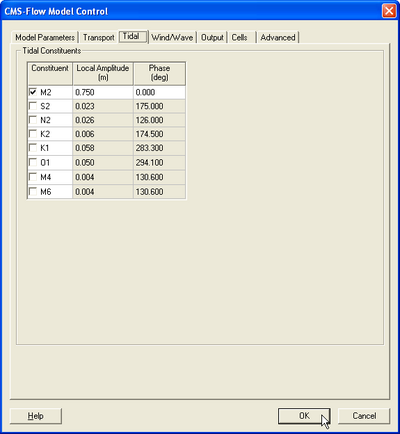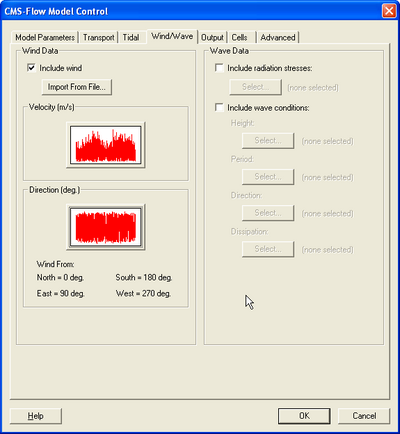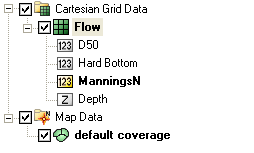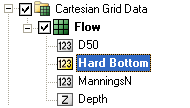CMS-Flow:Features: Difference between revisions
| Line 175: | Line 175: | ||
==Hard Bottom== | ==Hard Bottom== | ||
Hard Bottom is a morphologic constraint that provides the capability to simulate mixed bottom types within a single simulation. This cell-specific feature limits the erodibility of the constrained cells down to a specified depth below the water surface. More information on the use of hard bottom within the SMS can be found [[CMS-Flow:Hard_Bottom|'''here''']]. | [[Image:CMS-Flow_Hard-Bottom.png|thumb|right|400px| SMS Project Explorer showing Hard bottom dataset]]Hard Bottom is a morphologic constraint that provides the capability to simulate mixed bottom types within a single simulation. This cell-specific feature limits the erodibility of the constrained cells down to a specified depth below the water surface. More information on the use of hard bottom within the SMS can be found [[CMS-Flow:Hard_Bottom|'''here''']]. | ||
<br style="clear:both" /> | |||
==Variable D50== | ==Variable D50== | ||
Revision as of 15:27, 18 May 2010
Boundary Conditions
CMS-Flow has five types of boundary conditions which are listed and discussed below. The figure below shows the CMS-Flow Boundary Conditions window in SMS. All CMS-Flow boundary conditions are forced at the edges of the domain by use of cellstrings defined with the Surfacewater Modeling System (SMS). Cellstrings can either be created manually or using the SMS tool called Generate Along Boundary which is found under the Cellstring menu.
Land
The land boundary conditions is equivalent to a zero flux boundary condition. The land boundary condition is the default boundary condition when a cell string is created. It is not necessary to define land boundaries in the interior of the CMS-Flor domain, since land boundarys will automatically be detected by CMS-Flow based on the local water depths and the presence of inactive land cells.
Flow Rate-Forcing
The flow rate boundary condition specifies a time series of water fluxes in units of m^3/s per cell.
NOTES:
- Total flow rate specified is divided between the total number of cells in the cellstring with each carrying a portion of the total.
- This boundary type may only be specified along cell strings which are straight.
- The sign of the flow rate curve is dependent on the direction of flow with respect to the origin (always lower-left hand corner of the grid).
- This guide should assist in proper assignment:
- Flow rate from the East - Negative value
- Flow rate from the West - Positive value
- Flow rate from the North - Negative value
- Flow rate from the South - Positive value
Water Surface Elevation Forcing
Two types of Water Surface Elevation Forcing exist for CMS-Flow. Once a water surface elevation curve (or series of curves) is applied, the user is able to display the curve information graphically.
1. Define curve (single time series curve for each cell string)
User creates a cellstring for the given boundary and defines a time series curve. The value for each time on this curve is applied to all cells along the designated cellstring. The time series curve may be specified by either importing an SMS *.xys file, copying tabular data into SMS, or manually entered the time series information in SMS.
2. Extract from data set (time series curve for each cell on cell string)
User creates a cellstring for the given boundary and extracts multiple time series curves from a dataset or database. Each cell along the cellstring is given its own time-series curve information. Examples are:
- Extraction of water surface elevation values from a larger domain solution (ie. Larger CMS-Flow or ADCIRC grid)
- Extraction of tidal constituent information from a tidal database, from which a water surface elevation curve can be generated.
Tidal Constituent Forcing
CMS-Flow as the option of forcing with a harmonic tidal water surface elevation. To assign a boundary as a tidal boundary:
- Select a cellstring
- Click under CMS-Flow | Assign BC...
- In the CMS-Flow Boundary Conditions window, click on Tidal constituent-forcing, and click OK.
- Open the CMS-Flow Model Control window and click on the tab labeled Tidal.
- Enter the amplitudes and phases of the tidal constituents. Note that the same amplitude and phase are applied to entire cellstring and click OK

Water Surface Elevation and Velocity Forcing
Users are able to extract both water surface elevations and velocity components from a larger domain solution (ie. Larger CMS-Flow or ADCIRC grid).
Salinity Concentration Forcing
If salinity transport is active for the simulation, the user has the ability to use existing hydrodynamic cellstrings in the interface in order to provide a time-series curve of salinity concentrations. The salinity concentrations must be provided in units of ppt.
Global Forcing
There are two main types of global forcing available in CMS-Flow, wind and wave. Global forcing means that the forcing is applied on a cell-by-cell nature, rather than forcing along a boundary.
Wind Forcing
Wind Curve
Temporally varying, spatially constant winds are input in CMS in the Wind Section of the CMS-Flow Model Control Window. To add wind forcing to a current CMS-Flow project click on CMS-Flow | Model Control and then on the Wind/Wave tab. Activate wind forcing by clicking on the Include Wind check box. Winds may be imported using an *.m2w file or by specifying a curve for wind speed and direction. To specify a curve for each click on the respective box which says Curve undefined which will open the XY Series Editor. The time series may be manually entered, copied or imported from an *.xys file in the XY Series Editor.

Spatially Variable Wind and Atmospheric Pressure
CMS-Flow V4.0 and higher have the option to use spatially variable wind and atmospheric pressure forcing. Currently, this feature is specified in the advanced card section using the cards listed in the table below.
CMS-Flow cards related to wind
| Card | Arguments | Type |
|---|---|---|
| WIND_OUT_TIMES_LIST | Id number of output times list | integer |
| WIND_DRAG_COEFFICIENT | kappa in Hsu (1988) (default 0.4) | real |
| WIND_INPUT_CURVE | Name of model parameter file followed wind curve path | character |
| ANEMOMETER_HEIGHT | Height of wind speeds | meter |
| OCEANWEATHER_WIND_FILE | Name of Oceanweather, Inc. wind file (*.win) | character |
| OCEANWEATHER_PRES_FILE | Name of Oceanweather, Inc. pressure file (*.pre) | character |
| OCEANWEATHER_XY_FILE | Name of Oceanweather, Inc. coordinate file (*.xy) | character |
Wave Forcing
Temporally and spatially varying.
- Wave forcing is generally provided by the user selecting to use the Steering Module within SMS. The mapping of wave data from wave grid to flow grid is automated during the course of the steering process.
- If a choice is made not to use the steering process, the user must provide several datasets of information which has been mapped to the flow grid geometery.
- Radiation stress gradient
- Wave height
- Wave period
- Wave direction
- Wave dissipation
Transport Options
Sediment Transport
The sediment transport controls are located in the Transport section of the CMS-Flow Model Control window as shown in the figure below.

CMS-Flow includes three sediment transport models:
- Equilibrium Total load (Exner Equation)
- Equilibrium Bed load plus Non-Equilibrium Suspended Load
- Non-equilibrium Total load
All of the previously mentioned models account for hard bottom and effect of the bed slope.
The nearbed sediment concentation or concentration capacity are calculated with one of the following transport formula:
- Lund-CIRP (2006)
- Van Rijn (1998)
- Watanabe (1987)
- Soulsby-van Rijn (1997) (V4.0 and higher)
Equilibrium Total Load
In this model, both the bed load and suspended load are assumed to be in equilibrium. The bed change is solved using a simple mass balance equation known as the Exner equation.
More information on the this model can be found here.
Equilibrium Bed load plust Advection-Diffusion Suspended Load
Calculations of suspended load and bed load are conducted separately. The bed load is assumed to be in equilibrium and is included in the bed change equation while the suspended load is solved through the solution of an advection-diffusion equation.
More information on the this model can be found here.
Non-equilibrium Total Load
The non-equilibrium sediment transport algorithm (NET) simulates non-cohesive, single size sediment transport and bed change using a Finite Volume method and includes advection, diffusion, hiding and exposure, and avalanching. NET sediment transport is calculated with a non-equilibrium bed-material (total load) formulation. In this approach, the suspended- and bed-load transport equations are combined into a single equation and thus there is one less empirical parameter to estimate (adaptation length).
Additional information on NET can be found here.
Advanced Cards
| Card | Arguments | Description | Versions |
|---|---|---|---|
| GLOBAL_SEDIMENT_BUDGET | ON | OFF | Calculates the global sediment budget for the entire domain | >=v4.0 |
| SEDIMENT_FALL_VELOCITY | Sediment fall velocity in m/sec | Sets the sediment fall velocity to a constant | >=v4.0 |
| SEDIMENT_INFLOW_LOADING_FACTOR | Loading factor (0.25-1.5) | Used to specify under- or overloading at sediment inflow boundaries | >=v4.0 |
| CALC_MORPH_DURING_RAMP | ON | OFF | Determines whether to calculate the morphology change during the ramp period (default is ON) | >=4.0 |
Salinity Transport
In many estuaries, the density gradients caused by spatial variations in salinity can be an important driving force in the circulation. Salinity is also a key water quality variable in estuaries, since it affects the chemical and biological processes. Salinity is simulated in the Coastal Modeling System (CMS) in a depth-averaged sense. This means that the estuary or body of water is assumed to be well mixed vertically and the salinity is constant over the water column.
The salinity transport equation is solved with an explicit, finite volume method. The advection term is discretized with upwind scheme, and the diffusion term is discretized with the standard central difference scheme.
Additional information on Salinity Transport in CMS-Flow can be found here.
Other Processes
Bottom Friction

The bottom friction parameter (related to Manning ) is spatially varying (cell-specific) over the grid domain. The default value upon grid creation is 0.025. At times a user may desire to represent locations where added friction is needed due to structures or increased turbulence due to sharp changes in current speed. More information on using this feature of CMS-Flow can be found here.
| Card | Arguments | Description | Versions |
|---|---|---|---|
| MANNING_N_DATASET | Grid file name and dataset path | Specifies input Manning n dataset | >=v3.5 |
| WAVE-CURRENT_MEAN_STRESS | W09 | DATA2 | DATA13 | F85 | HT95 | Defines the model used for calculating the mean bottom shear stress used in hydro | >=4.0 |
| USE_WALL_FRICTION | ON | OFF | Turns on or off wall friction | >=3.5 |
Hard Bottom

Hard Bottom is a morphologic constraint that provides the capability to simulate mixed bottom types within a single simulation. This cell-specific feature limits the erodibility of the constrained cells down to a specified depth below the water surface. More information on the use of hard bottom within the SMS can be found here.
Variable D50
When sediment transport and morphology change are activated, sometimes it may be desired to designate areas of the grid to have a certain grain size. This cell-specific parameter allows each cell to take on the characteristics of a certain sediment grain size. More information on the use of variable grain size (D50) can be found here.
Eddy Viscosity
Eddy Viscosity in CMS-Flow is not a user definable parameter. It is presently calculated with a subgrid turbulence model. More information can be found here.
Other Features
Parallelization with OpenMP
Both Intel and AMD processors now are shipping chips with multiple cores/processors (henceforth referred to as "processors") available. CMS-Flow is now configured to make use of these extra processes that are available on newer machines.
Additional information on using Multiple Processors with CMS-Flow can be found here.
Units of Measurement
| Variable | Units | Symbol |
|---|---|---|
| Water Surface Elevation | meters | () |
| Current Velocity | meters per second | () |
| Flow Rate | cubic meters per second | () |
| Salinity Concentration | parts per thousand | () |
| Sediment Concentration | kilogram per meter cubed | () |
| Sediment Transport | meter squared per second | () |
